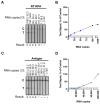Comparative Evaluation of Rapid Isothermal Amplification and Antigen Assays for Screening Testing of SARS-CoV-2
- PMID: 35336875
- PMCID: PMC8951466
- DOI: 10.3390/v14030468
Comparative Evaluation of Rapid Isothermal Amplification and Antigen Assays for Screening Testing of SARS-CoV-2
Abstract
Human transmission of SARS-CoV-2 and emergent variants of concern continue to occur globally, despite mass vaccination campaigns. Public health strategies to reduce virus spread should therefore rely, in part, on frequent screening with rapid, inexpensive, and sensitive tests. We evaluated two digitally integrated rapid tests and assessed their performance using stored nasal swab specimens collected from individuals with or without COVID-19. An isothermal amplification assay combined with a lateral flow test had a limit of detection of 10 RNA copies per reaction, and a positive percent agreement (PPA)/negative percent agreement (NPA) during the asymptomatic and symptomatic phases of 100%/100% and 95.83/100%, respectively. Comparatively, an antigen-based lateral flow test had a limit of detection of 30,000 copies and a PPA/NPA during the asymptomatic and symptomatic phases of 82.86%/98.68% and 91.67/100%, respectively. Both the isothermal amplification and antigen-based lateral flow tests had optimized detection of SARS-CoV-2 during the peak period of transmission; however, the antigen-based test had reduced sensitivity in clinical samples with qPCR Ct values greater than 29.8. Low-cost, high-throughput screening enabled by isothermal amplification or antigen-based techniques have value for outbreak control.
Keywords: SARS-CoV-2; antigen test; isothermal molecular test; screening; surveillance; testing.
Conflict of interest statement
This work was supported by E25Bio, Inc. N.S., B.F.S. and B.B.H. are employed by E25Bio, Inc., a company that develops rapid diagnostic tests for infectious diseases. At the time of the study, X.Q. was employed by E25Bio, Inc. B.B.H. is an inventor on a U.S. Provisional Patent Application (63/189,502).
Figures



Similar articles
-
Rapid Detection of SARS-CoV-2 Using Duplex Reverse Transcription-Multienzyme Isothermal Rapid Amplification in a Point-of-Care Testing.Front Cell Infect Microbiol. 2021 Oct 22;11:678703. doi: 10.3389/fcimb.2021.678703. eCollection 2021. Front Cell Infect Microbiol. 2021. PMID: 34746020 Free PMC article.
-
Lumipulse G SARS-CoV-2 Ag assay evaluation using clinical samples from different testing groups.Clin Chem Lab Med. 2021 Apr 7;59(8):1468-1476. doi: 10.1515/cclm-2021-0182. Print 2021 Jul 27. Clin Chem Lab Med. 2021. PMID: 33823089
-
Evaluation of a laboratory-based high-throughput SARS-CoV-2 antigen assay.Clin Chem Lab Med. 2022 Jun 14;60(9):1478-1485. doi: 10.1515/cclm-2022-0360. Print 2022 Aug 26. Clin Chem Lab Med. 2022. PMID: 35700973
-
Evaluating the field performance of multiple SARS-Cov-2 antigen rapid tests using nasopharyngeal swab samples.PLoS One. 2022 Feb 14;17(2):e0262399. doi: 10.1371/journal.pone.0262399. eCollection 2022. PLoS One. 2022. PMID: 35157700 Free PMC article.
-
Current strategies for SARS-CoV-2 molecular detection.Anal Methods. 2022 Nov 24;14(45):4625-4642. doi: 10.1039/d2ay01313d. Anal Methods. 2022. PMID: 36349688 Review.
Cited by
-
Nasal swab is a good alternative sample for detecting SARS-CoV-2 with rapid antigen test: A meta-analysis.Travel Med Infect Dis. 2023 Mar-Apr;52:102548. doi: 10.1016/j.tmaid.2023.102548. Epub 2023 Feb 9. Travel Med Infect Dis. 2023. PMID: 36758806 Free PMC article.
-
Performance of self-performed SARS-CoV-2 rapid antigen test: a systematic review and meta-analysis.Front Public Health. 2024 Oct 18;12:1402949. doi: 10.3389/fpubh.2024.1402949. eCollection 2024. Front Public Health. 2024. PMID: 39494084 Free PMC article.
-
RT-RPA as a dual tool for detection and phylogenetic analysis of epidemic arthritogenic alphaviruses.Sci Rep. 2024 Dec 3;14(1):30134. doi: 10.1038/s41598-024-81763-7. Sci Rep. 2024. PMID: 39627454 Free PMC article.
-
Comparison of diagnostic accuracy of rapid antigen tests for COVID-19 compared to the viral genetic test in adults: a systematic review and meta-analysis.JBI Evid Synth. 2024 Oct 1;22(10):1939-2002. doi: 10.11124/JBIES-23-00291. JBI Evid Synth. 2024. PMID: 39188132 Free PMC article.
-
Development of an RT-RPA assay for La Crosse virus detection provides insights into age-dependent neuroinvasion in mice.Virol J. 2025 Apr 9;22(1):95. doi: 10.1186/s12985-025-02720-y. Virol J. 2025. PMID: 40205618 Free PMC article.
References
-
- El Sahly H.M., Baden L.R., Essink B., Doblecki-Lewis S., Martin J.M., Anderson E.J., Campbell T.B., Clark J., Jackson L.A., Fichtenbaum C.J., et al. Efficacy of the mRNA-1273 SARS-CoV-2 Vaccine at Completion of Blinded Phase. N. Engl. J. Med. 2021;385:1774–1785. doi: 10.1056/NEJMoa2113017. - DOI - PMC - PubMed
-
- CDC Mitigation Measures for COVID-19 in Households and Markets in Non-US Low-Resource Settings. [(accessed on 18 December 2021)];2021 Available online: https://www.cdc.gov/coronavirus/2019-ncov/global-covid-19/global-urban-a....
-
- CDC Testing Strategies for SARS-CoV-2. [(accessed on 18 December 2021)];2021 Available online: https://www.cdc.gov/coronavirus/2019-ncov/lab/resources/sars-cov2-testin....
Publication types
MeSH terms
LinkOut - more resources
Full Text Sources
Medical
Miscellaneous

